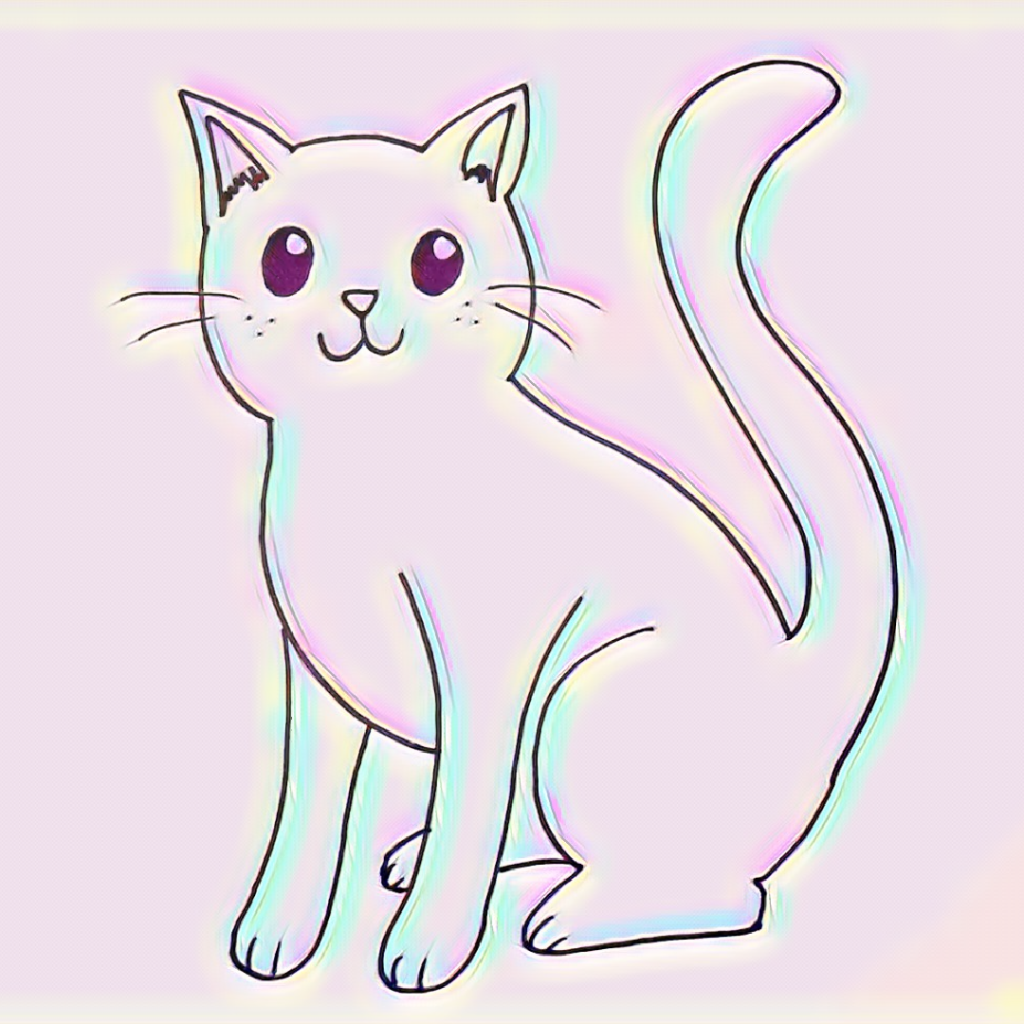Introduction:
Cat Drawing has become incredibly popular among artists of all levels. Whether you’re a newbie looking for exploring your artistic skills or an experienced artist seeking to enhance your feline artwork, this ultimate guide is here to help you out. By providing valuable tips and tricks, this guide will assist you in creating stunning cat drawings that capture the essence and charm of these graceful creatures.

Why cat drawing is so popular?
Cats have an undeniable allure that has captivated artists throughout history. Their elegance, mysteriousness, and unique personalities make them fascinating subjects for artistic expression. Drawing cats allows artists to depict the grace and agility of these creatures, as well as their various expressions and body language.

How this guide will help you to enhance your cat drawing
This comprehensive guide aims to equip you with the knowledge and techniques needed to create impressive cat drawings, regardless of your skill level. From the basics of setting up your workspace and selecting the right materials to advanced tips for shading and capturing intricate details, this guide covers it all. Let’s dive in and discover the art of your cat drawing!
Getting Started:
Materials you will need
Before you begin your cat drawing journey, it’s essential to gather the right materials. You’ll need quality pencils, erasers, paper, and other tools that suit your preferred drawing style. Trying out a variety of materials allows you to discover the ones that align with your artistic vision.

Setting up your workspace
Creating a comfortable and inspiring workspace is crucial for optimal creativity. Organize your art supplies, ensure sufficient lighting, and set up a dedicated area where you can focus on your drawings without distractions. A well-organized workspace will enhance your productivity and help you fully immerse yourself in the drawing process.
Tips for sketching and line drawing
Sketching and line drawing form the foundation of any cat drawing. Practice loose, gestural sketches to capture the basic proportions and pose of a cat. Use light, confident strokes to establish the general shape, and gradually refine the details. Experiment with different line weights and techniques to add depth and dimension to your drawings.

Understanding feline anatomy
To create realistic cat drawings, it’s crucial to have a solid understanding of feline anatomy. Study the bones and muscles that give cats their distinct form and structure. Familiarize yourself with the proportions of a cat’s body and how they vary across different breeds. This knowledge will help you accurately depict cats in various poses and positions.
How to depict different breeds and coat patterns
The world of cats encompasses a vast array of breeds, each boasting its own distinct characteristics and mesmerizing coat patterns. Delve into the realm of research and immerse yourself in studying the intricate traits of various breeds, from the graceful curves of their faces to the captivating shapes of their ears and tails. Pay attention to the patterns and textures of their fur, as this will greatly enhance the realism of your drawings.
Tips for drawing cats in different poses
Capturing the dynamic nature of cats in various poses adds life and energy to your drawings. Experiment with drawing cats in different positions, such as sitting, lounging, or leaping. Pay attention to the angles and proportions of their bodies, and practice conveying their graceful movements.

Techniques for shading and texturing:
Using light and shadow
Mastering the art of shading is essential for adding depth and dimension to your cat drawings. Understand how light interacts with various surfaces and experiment with different shading techniques, such as hatching, cross-hatching, and blending. Observing real-life lighting conditions and studying photographs of cats can help you develop your shading skills.
Tips for creating realistic fur texture
The texture of a cat’s fur is a defining feature that adds realism to your drawings. Experiment with different pencil strokes to create the illusion of fur, whether it’s short and smooth or long and fluffy. Pay attention to the direction and flow of the fur, and gradually build up layers of shading to achieve a realistic and tactile effect.

How to draw reflective surfaces like cat eyes
Cat eyes possess a captivating luminosity that can be challenging to capture. Immerse yourself in the captivating world of a cat’s eyes, where intricate details await your study. Take a closer look at the mesmerizing shape of the iris, the dance of highlights, and the enchanting play of reflections within those feline orbs. Use a combination of light shading and precise lines to depict the reflective surfaces of the eyes, making them appear alive and full of depth.
Adding personality to your cat drawing
Beyond capturing the physical attributes of cats, it’s essential to convey their unique personalities through your drawings. Pay attention to their expressions, body language, and subtle nuances. Experiment with different facial expressions and poses to depict various moods and emotions, showcasing the individuality of each cat you draw.

Cat expressions and body language
Cats communicate a wide range of emotions through their expressions and body language. Learn to observe and interpret these signals, as they will help you create more expressive and engaging cat drawings. Whether it’s a playful cat, a contented one, or a curious feline, understanding their body language adds depth and authenticity to your artwork.
Capturing the cat’s playful behavior
Cats are known for their playful nature, and capturing their joyful antics can bring a sense of liveliness to your drawings. Observe cats during playtime and take note of their poses, movements, and interactions with toys or other objects. Incorporate these dynamic elements into your artwork, conveying the energy and enthusiasm that cats exude.

Demonstrating characteristics of different cat breeds
Different cat breeds have distinct characteristics that set them apart. Showcase these unique traits in your drawings by paying attention to details such as ear shape, facial structure, and body proportions. Whether it’s the regal appearance of a Siamese or the round features of a British Shorthair, emphasizing these traits adds authenticity to your cat drawings.
Gift:
Claim our premium worksheet practice book For Free (Only for you) :
How to practice cat drawing:
Finding inspiration for cat drawing
Set free the boundless essence of your creative spirit and embark on a quest to discover the inspiration that awaits in a multitude of realms. Explore the realms of books, delve into the depths of websites, immerse yourself in the captivating world of social media, or embark on real-life interactions with the mesmerizing creatures that are cats. Explore different sources and collect reference images that inspire you. Study the works of other artists who specialize in cat drawings, noting their techniques and approaches. Immersing yourself in a cat-centric artistic environment will fuel your creativity and help you develop your own unique style.
Creating a cat drawing routine
Consistency is key when it comes to improving your cat drawing skills. Set aside dedicated time for regular practice sessions. No matter if you dedicate a mere few minutes each day or indulge in longer drawing sessions a few times a week, establishing a consistent routine paves the way for steady progress on your artistic journey. Treat your cat drawing practice as a form of self-expression and relaxation, allowing yourself to enjoy the process without putting too much pressure on the outcome.

Tips for staying motivated
Like any creative pursuit, learning to draw cats requires patience and perseverance. Stay motivated by setting achievable goals and celebrating your progress along the way. Join online communities or local art groups that share your passion for cat drawing, as this can provide a sense of camaraderie and encouragement. Remember to embrace the journey and find joy in every stroke of your pencil.
Tips for different levels of experience
Whether you’re a beginner, intermediate artist, or advanced practitioner, there are specific tips tailored to each level:
Drawing tips for beginners:
- Start with basic shapes and practice drawing simple cat silhouettes.
- Focus on understanding proportions and capturing the overall form of a cat.
- Gradually introduce more details as you gain confidence.
- Embrace the beauty of imperfection and banish the fear of making mistakes, for they serve as indispensable stepping stones along the path of learning and growth.
Intermediate drawing techniques:
- Experiment with different shading techniques to add depth and dimension to your drawings.
- Practice drawing cats in various poses and angles to improve your understanding of anatomy.
- Study different fur textures and practice replicating them in your artwork.
- Seek constructive feedback from fellow artists to refine your skills.

Advanced cat drawing challenges:
- Push the boundaries of your creativity by experimenting with unconventional compositions and perspectives.
- Explore different artistic styles and techniques, such as impressionism or abstraction.
- Dive deeper into the intricacies of cat anatomy, focusing on smaller details and capturing subtle nuances.
- Share your expertise with others by teaching or mentoring aspiring cat artists.
Mistakes to avoid when drawing cat:
Common mistakes to watch out for:
As you progress in your cat drawing journey, be mindful of these common mistakes:
- Inaccurate proportions: Pay attention to the relative sizes and positions of different body parts to ensure a well-proportioned cat drawing.
- Lack of depth: Avoid creating flat, two-dimensional drawings by incorporating shading and highlighting techniques.
- Overcomplicating details: Start with the basic structure and gradually add details, avoiding overwhelming yourself with too much complexity early on.
- Unrealistic poses: Study cats in different positions and practice drawing them from various angles to avoid stiff and unnatural-looking poses.

Tips for correcting mistakes when you make them:
Making mistakes is inevitable, but they also provide valuable learning opportunities. When you encounter mistakes in your cat drawings, try these corrective steps:
- Assess the error: Identify the specific area or aspect that needs improvement.
- Analyze references: Study real cats or reference images to understand how to correct the mistake.
- Practice specific techniques: Focus on the skills or techniques necessary to rectify the error, such as shading or capturing proportions.
- Iterate and refine: Redraw the problem area, incorporating your newfound knowledge and skills.
- Seek feedback: Share your corrected drawings with fellow artists or mentors to receive constructive criticism and guidance.
Bonus:
You may check out our most helpful article about how you can help your child to do extremely well in drawing https://bloggchain.com/15-newest-techniques-to-improving-your-car-drawing/
How to assess your own drawings for improvement:
Self-assessment plays a vital role in improving your cat drawing skills. Here’s how you can evaluate your drawings:
- Compare to references: Compare your drawings to real cats or reference images, looking for discrepancies in proportions, details, or overall likeness.
- Identify strengths and weaknesses: Recognize the areas where you excel and the aspects that require improvement.
- Set specific goals: Determine what you want to improve and focus on those areas in your practice sessions.
- Keep a sketchbook: Keep a faithful companion in the form of a sketchbook, serving as a vessel to document your artistic odyssey. Within its pages, witness the remarkable evolution of your skills and bask in the joy of tracking your progress over time.
- Embrace continuous learning: Stay curious and open to new techniques and perspectives to refine your artistic abilities.
Learning from others:
How to participate in cat drawing communities:
Engaging with a community of cat drawing enthusiasts can be an enriching experience. Here’s how you can get involved:
- Join online forums or social media groups dedicated to cat drawing.
- Share your drawings and participate in challenges or themed events.
- Interact with fellow artists, ask questions, and offer feedback and support.
- Attend local art meetups or workshops focused on cat drawing.
- Collaborate with other artists on cat-related projects or exhibitions.
Tips for getting feedback on your cat drawing:
Receiving feedback from others is invaluable for your artistic growth. Consider these tips when you are seeking feedback:
- Be open to constructive criticisms: Embrace feedback as an opportunity to learn & improve, rather than taking it personally.
- Specify areas of focus: Ask for feedback on specific aspects of your drawings, such as proportions, shading, or capturing expressions.
- Engage in dialogue: Discuss and clarify feedback with the person providing it to gain a deeper understanding of their perspective.
- Consider multiple viewpoints: Seek feedback from different sources to gain a variety of insights and suggestions.

Finding inspiration from other artists:
Drawing inspiration from other artists can spark creativity and help you expand your artistic horizons. Here’s how you can find inspiration:
- Explore art galleries, museums, and exhibitions featuring cat-themed artwork.
- Follow cat artists on social media platforms to discover their unique styles and techniques.
- Study the works of master artists who have excelled in depicting animals, including cats.
- Analyze and deconstruct the techniques and approaches used by artists you admire.
- Experiment with incorporating elements from different artistic styles into your own cat drawings.
Conclusion:
In this ultimate guide to cat drawing, we’ve covered a wide range of tips and techniques to help artists at every level improve their feline artwork. From understanding feline anatomy and capturing different poses to mastering shading and adding personality to your drawings, this guide has provided a comprehensive overview of the cat drawing process. Remember, practice and perseverance are essential on your artistic journey. Keep exploring, experimenting, and creating, and let your love for cats guide your artistry.

FAQs
- Do I need to have a lot of experience in cat drawing?
- No, you don’t need to have a lot of experience to start cat drawing. This guide provides tips and techniques suitable for beginners, intermediate artists, and advanced practitioners. With dedication and practice, anyone can improve their cat drawing skills.
- What types of materials do I need for drawing a cat?
- The materials you’ll need for drawing a cat include pencils of various grades, erasers, paper or sketchbooks, and optional tools like blending stumps or tortillons. Experiment with different materials and find what works best for your preferred drawing style.
- How can I stop getting discouraged when I make mistake?
- Mistake is an essential part of the learning process. Instead of getting discouraged, view them as opportunities for growth and improvement. Embrace a growth mindset and celebrate the progress you make with each drawing.
- Can I learn to draw a cat in a week?
- Becoming proficient at drawing cats takes time and practice. While you can certainly make progress in a week, developing a solid foundation and achieving mastery requires ongoing dedication and commitment. Embrace the journey and enjoy the process of continuous improvement.
Sponsored By:
Check out the best and most affordable digital marketing services that can take your business to the next level http://elonmusktrillion.com




Pingback: Exciting Mushroom Drawing in Just 5 Minutes - Bloggchain